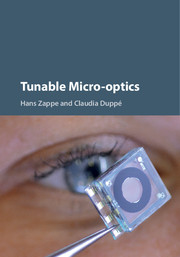Book contents
- Frontmatter
- Dedication
- Contents
- List of contributors
- List of acronyms
- Part I Introduction
- Part II Devices and materials
- 3 Soft-Matter Micro-optics
- 4 Tunable Reflective Optics
- 5 Tunable Liquid Lenses
- 6 Optofluidic Micro-shutters and Micro-irises
- 7 Solid Body Elastomeric Lenses
- 8 Spatially Tunable Polarization Devices
- 9 Aluminum Nitride and Diamond Membranes for Tunable Micro-optics
- 10 Piezoelectrically Actuated Tunable Microlenses
- Part III Systems and Applications
- Index
- References
6 - Optofluidic Micro-shutters and Micro-irises
from Part II - Devices and materials
Published online by Cambridge University Press: 05 December 2015
- Frontmatter
- Dedication
- Contents
- List of contributors
- List of acronyms
- Part I Introduction
- Part II Devices and materials
- 3 Soft-Matter Micro-optics
- 4 Tunable Reflective Optics
- 5 Tunable Liquid Lenses
- 6 Optofluidic Micro-shutters and Micro-irises
- 7 Solid Body Elastomeric Lenses
- 8 Spatially Tunable Polarization Devices
- 9 Aluminum Nitride and Diamond Membranes for Tunable Micro-optics
- 10 Piezoelectrically Actuated Tunable Microlenses
- Part III Systems and Applications
- Index
- References
Summary
Introduction
In contrast to microfluidic systems, which have reached a high level of sophistication and have been demonstrated in myriad forms, the application of liquids to micromechanical and also micro-optical systems is still at an early stage of development. Yet, as we will see in this chapter, when liquids are employed as a permanent structure, they can greatly enhance the functionality of a micro-system.
Within micro-optics, the use of microscale liquid volumes has consequently resulted in the rapidly developing research field of optofluidics. Optofluidics essentially aims at fusing microfluidics with micro-optics (Psaltis et al. 2006) to achieve tunable and highly compact micro-optical components. As there is a host of physical effects that result from the microscale interaction of fluids with light, more and more scientists and engineers are eager to find ways of exploiting these effects for a large variety of applications. Examples of optofluidic research topics in recent years include novel light sources, such as dye lasers, lateral microlenses, liquid waveguides and filters, tunable gratings, prisms, and photonic crystals, and even metrology systems such as interferometers and refractometers.
One property of liquids that may be employed to great benefit is optical absorption. Since the optical attenuation of a liquid can be easily altered by the addition of colorants or by varying the optical path length, many devices have been conceived which use liquids as variable optical absorbers. For example, optofluidic designs have been developed for displays (either based on tiny droplets of colored oils or aqueous pigment dispersions), for optical switches, for variable optical attenuators, and also for tunable apertures (e.g., irises).
In this chapter, we present recent research from our group and others, aiming at micro-optical apertures that are tunable. It is important to note that in these devices, tunability is achieved by taking advantage of unique properties offered only by liquids. After illuminating the motivation for using liquids in optics, we will take a glance at the current state of development and also at future prospects of commercialization of optofluidic devices. Some basic information on the importance of optical apertures and on fundamental microfluidic principles will be beneficial before we narrow our view to optofluidic approaches for tuning micro-optical apertures. Finally, the remaining and major part of this chapter will be dedicated to the presentation of detailed results of our own research on optofluidic shutters and irises.
Information
- Type
- Chapter
- Information
- Tunable Micro-optics , pp. 156 - 175Publisher: Cambridge University PressPrint publication year: 2015
